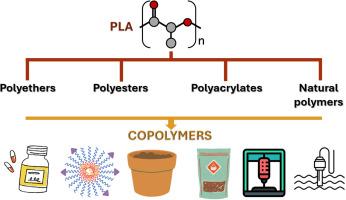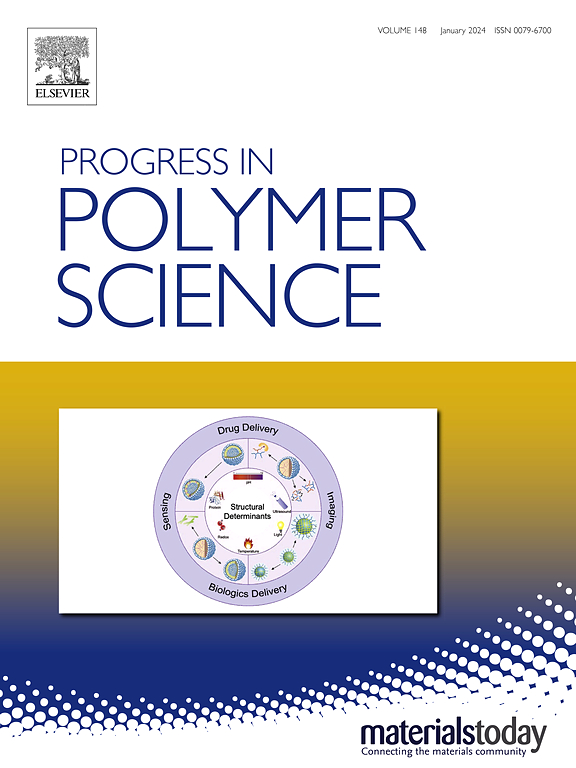A decade of innovation: Synthesis, properties and applications of PLA copolymers
IF 26.1
1区 化学
Q1 POLYMER SCIENCE
引用次数: 0
Abstract
Over the past decade, poly(lactic acid) (PLA) copolymers have emerged as a versatile class of materials, offering enhanced properties and broader application potential compared to neat PLA. As the leading biobased plastic, PLA has high strength, good processability, and industrial compostability; however, its brittleness, limited thermal stability, and slow (bio)degradation under ambient conditions hinder its widespread adoption in advanced applications. This review provides a comprehensive analysis of PLA-based copolymers, excluding PLA stereoisomers and poly(lactic-co-glycolic acid) (PLGA), focusing on their synthesis, structure-property relationships, and potential uses. Copolymerization strategies—including ring-opening polymerization (ROP), polycondensation, and controlled radical polymerization—enable precise control over PLA’s mechanical, thermal, and degradation characteristics. The incorporation of diverse comonomers, such as lactones, diacids, diols, poly(ethylene glycol) (PEG), and naturally derived polymers, has led to copolymers with tuneable properties suited for packaging, textiles, biomedical applications, and sustainable materials engineering. Advances in block, random, and graft copolymer architectures further expand PLA's functionality, enabling the design of high-performance biobased materials. By summarizing recent findings, this review highlights how tailored PLA copolymers are shaping the future of sustainable polymers.


创新的十年:聚乳酸共聚物的合成、性能和应用
在过去的十年中,聚乳酸(PLA)共聚物已经成为一种多用途的材料,与纯PLA相比,具有增强的性能和更广泛的应用潜力。作为领先的生物基塑料,PLA具有高强度、高加工性和工业可堆肥性;然而,它的脆性、有限的热稳定性和在环境条件下缓慢的(生物)降解阻碍了它在高级应用中的广泛采用。本文综述了聚乳酸基共聚物(不包括聚乳酸立体异构体和聚乳酸-羟基乙酸)(PLGA),重点介绍了它们的合成、结构-性能关系和潜在用途。共聚策略-包括开环聚合(ROP),缩聚和可控自由基聚合-可以精确控制PLA的机械,热和降解特性。不同共聚单体的结合,如内酯、二酸、二醇、聚乙二醇(PEG)和天然衍生聚合物,导致共聚物具有可调节的性能,适用于包装、纺织品、生物医学应用和可持续材料工程。嵌段、随机和接枝共聚物结构的进步进一步扩展了PLA的功能,使高性能生物基材料的设计成为可能。通过总结最近的发现,这项工作强调了定制PLA共聚物如何塑造可持续聚合物的未来。
本文章由计算机程序翻译,如有差异,请以英文原文为准。
求助全文
约1分钟内获得全文
求助全文
来源期刊

Progress in Polymer Science
化学-高分子科学
CiteScore
48.70
自引率
1.10%
发文量
54
审稿时长
38 days
期刊介绍:
Progress in Polymer Science is a journal that publishes state-of-the-art overview articles in the field of polymer science and engineering. These articles are written by internationally recognized authorities in the discipline, making it a valuable resource for staying up-to-date with the latest developments in this rapidly growing field.
The journal serves as a link between original articles, innovations published in patents, and the most current knowledge of technology. It covers a wide range of topics within the traditional fields of polymer science, including chemistry, physics, and engineering involving polymers. Additionally, it explores interdisciplinary developing fields such as functional and specialty polymers, biomaterials, polymers in drug delivery, polymers in electronic applications, composites, conducting polymers, liquid crystalline materials, and the interphases between polymers and ceramics. The journal also highlights new fabrication techniques that are making significant contributions to the field.
The subject areas covered by Progress in Polymer Science include biomaterials, materials chemistry, organic chemistry, polymers and plastics, surfaces, coatings and films, and nanotechnology. The journal is indexed and abstracted in various databases, including Materials Science Citation Index, Chemical Abstracts, Engineering Index, Current Contents, FIZ Karlsruhe, Scopus, and INSPEC.
 求助内容:
求助内容: 应助结果提醒方式:
应助结果提醒方式:


